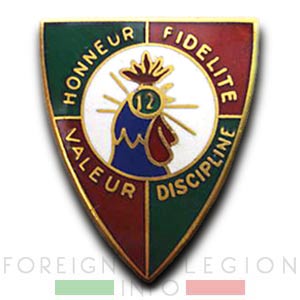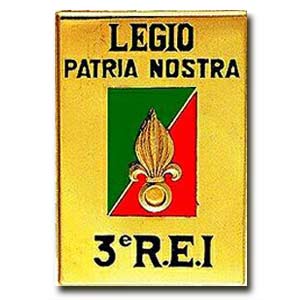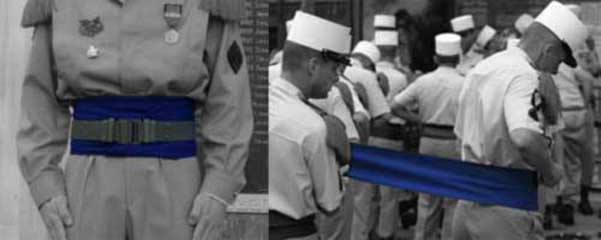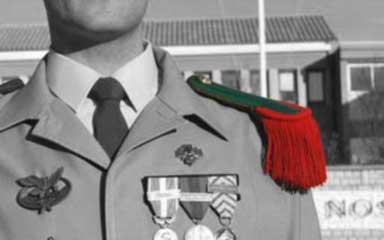Camerone Day and the hand of Captain Danjou
Fête de Camerone et la main du capitaine Danjou. Camerone Day marks the most significant event in the French Foreign Legion’s history, the Battle of Camerone. It became a symbol of bravery and the determination to fight to the finish. The battle occurred in Mexico on April 30, 1863. A Legion company, consisting of 3 officers and 62 legionnaires led by Captain Jean Danjou, faced almost 2,000 Mexicans. Captain Danjou and his men refused to surrender and continued to fight until their ammunition ran out. At the end of the battle, only three combat-ready legionnaires were left.
Camerone Day, an annual official festivity open to public, has been held by the Legion since 1931, to commemorate this pivotal event. That day in the Motherhouse of the Foreign Legion, the wooden hand of Captain Danjou (who lost his left hand in Algeria in the 1850s) is paraded. It is carried by a specially selected individual, either a well-respected veteran of the Legion or a very important person connected to the Legion. For Legion veterans – officers, NCOs, or simple legionnaires – carrying the wooden hand of Captain Danjou on Camerone Day is perceived as the highest honor. The Narration of Camerone (Recit de Camerone), the telling of the story, is inseparable from the ceremony.
Camerone Day is celebrated by even the smallest Legion unit in the most remote post.
See more details on this significant action: 1863 Battle of Camerone

The traditional colors of the French Foreign Legion
Les couleurs de tradition. The traditional colors of the French Foreign Legion are green and red (Le vert et le rouge). The exact origins of the Legion adopting these colors are officially unknown. The current thesis attributes the colors’ origins to the green uniform of Swiss legionnaires from the 2nd Foreign Legion (2e Légion étrangère, nicknamed as Swiss Legion, 1855-1856). The Swiss Legion merged with the original one in 1856 and the green uniform was abolished in 1859. However, the uniform was only green, not green and red.
The private thesis of the Foreign Legion Info website’s administrator and the author of this text is that we should search for the origins of the Foreign Legion’s green and red colors in the campaign medal issued by the French emperor Napoleon III in 1863 for soldiers fighting in Mexico (1862-67). This was a fateful campaign for the Legion, which included the famous Battle of Camerone.


Mottos of the French Foreign Legion
Devises de la Légion étrangère. There have been three main mottos within the Foreign Legion since its creation to summarize the general motivation of this exceptional unit.
Valeur et Discipline. Valor and Discipline. The first long-used motto of the French Foreign Legion. This motto originated from the French Army of the First Empire (1804–1814). The Foreign Legion began using it in December 1848, while a part of the French Army of Napoleon III‘s Second Republic (1848–1851). It was emblazoned on the Legion’s regimental flags. The motto disappeared from the flags after WWI, in 1920, and lost its importance during the Second World War. After the end of the First Indochina War (1946-1954), marked with the decisive Battle of Dien Bien Phu, the Legion ceased using the motto entirely.


Honneur et Fidélité. Honor and Fidelity. The second long-used motto of the French Foreign Legion. Unlike the rest of the French Army, which uses the motto Honneur et Patrie (Honor and Fatherland) on their regimental flags, the Foreign Legion uses the motto Honneur et Fidélité. This is said to originate from the motto of the Régiment de Diesbach (1721-1806), the Swiss unit within the French Imperial Army.
The current official thesis says that the motto has probably been used within the Legion since the 1850s, when the 2nd Foreign Legion (Swiss Legion) was integrated into the original Foreign Legion. However, the motto Valeur et Discipline was predominately used until the late 1910s, even on regimental flags. In 1920, a ministry decree prescribed that the motto Honneur et Fidélité should appear on all regimental flags of the Legion, both current and future. The motto has been emblazoned on them since then.

Legio Patria Nostra. The Legion is our Fatherland/Homeland. The third and newest motto of the French Foreign Legion. Currently the most frequently used motto in the Legion. Initially, it was used by legionnaires in Morocco in the 1920s, within the 3e REI. Following the First Indochina War, it became the main motto of the whole Legion. Nowadays, Legio Patria Nostra is the best-known motto of the Foreign Legion outside the institution.
Officially, the Legio Patria Nostra motto has an unknown origin, however. The private thesis of the author of this text is that we should search for the origins of the motto in the large reorganization of the Legion in 1920-1921. At the time, Lieutenant Colonel Paul-Frédéric Rollet, the then commander of the 3e REI and the future Father of the Legion, made an effort to return discipline and esprit de corps into the institution (which had been considerably affected by WWI), to unite all legionnaires into a strong family with its own identity and character. Such a motto perfectly meets those ideas. This thesis is supported by the fact that the first known use of the motto is the 3e REI’s badge from the 1920s.


Seven-flame grenade of the French Foreign Legion
La grenade à sept flammes. The official symbol of the Foreign Legion is the seven-flame grenade. In 1873, the Foreign Regiment (Régiment étranger) took on a grenade with flames as their new symbol. In the 1930s, the attribute had already taken the form we know today: seven flames spreading from the grenade. As a typical symbol of the Legion, two flames are always directed downwards, in contrast with the rest of the French Army.

Buttons of the French Foreign Legion
Les boutons. The buttons are very distinctive elements of the French Foreign Legion uniform. The Legion was created by a royal ordinance issued by French King Louis Philippe on March 10, 1831. In this ordinance, in Article 3, there is a sentence: “The buttons will be yellow and will carry the words Légion étrangère.” Today, the Legion’s buttons are still yellow (goldish) and carry these words.

White kepi of the French Foreign Legion
Le Képi blanc. The official thesis says that legionnaires in North Africa prior to WWI wore a kepi with a khaki-colored cover during operations. After some time, due to the frequent washing and strong sun, the covers turned white. However, we know that in Algeria and Morocco before WWI, several French regular units used a white-covered kepi as well, and even used it in France. Following the end of WWI, legionnaires wore a white-covered kepi mainly in Morocco, which was considered a foreign theater of operations. In Algeria, they wore the prescribed red and blue kepi. The 4e REI in Morocco was partly an exception, and used both versions. In the late 1930s, the rules were standardized. Thus, officially, French citizens in metropolitan France saw legionnaires in white-covered kepi for the first time on 14 July 1939, at the well-known annual military parade in Paris.
After WWII, kepis were once again covered with a khaki-colored cover for instruction or operations. A kepi with the white cover – designed for parades, guards, or walking-out uniforms – became the prescribed cap for the Legion in 1959. Nevertheless, a khaki cover was still used during basic instruction afterwards, until the 1970s. Today, legionnaires use non-covered white kepis solely.
The Legion is the only unit of the French Army using the white kepi. The white kepi is worn by ordinary legionnaires for guard duty, military ceremonies, or as part of their walking out uniform. Officers and non-commissioned officers wear a black kepi, as well as senior corporals (Caporal-chefs) with more than 17.5 years of service and a CT1 (Certificat technique) qualification.

Blue sash of the French Foreign Legion
La ceinture bleue. From the 1830s, colored sashes were worn by French soldiers on their clothes as a protection against intestinal disorders and to keep soldiers warm during the cold nights in Africa. After 1862, these sashes became a decorative attribute of troops from the French Army of Africa instead. In 1882, the Foreign Legion officially obtained a blue sash. Today, the blue sash is part of the Foreign Legion Parade Dress Uniform. It is 13.8 feet (4.20 m) in length and 15.8 inches (40 cm) in width.

Traditional epaulettes of the French Foreign Legion
Les épaulettes de tradition. They were used for the first time in 1868. Since 1946, the epaulettes have been an integrated part of the parade dress uniform within the French Army. The Foreign Legion uses epaulettes in green and red colors, the official colors of the Legion.

Green necktie of the French Foreign Legion
La cravate verte. First green ties were worn shortly in Sidi Bel Abbes (the then Legion’s HQ in Algeria) in the early 1930s, by unmarried lieutenants. Within the Legion shortly before WWII, prescribed ties were khaki or black. In 1945, a large free stock of green ties was discovered by the legionnaires in France. It was originally destined for the French Youth (CJF), a Vichy France paramilitary state organization. The legionnaires seized it and, since then, a green tie became an inseparable part of the Legion’s parade dress uniform. Today, the Legion is the only unit of the French Army that uses the green necktie.

Green beret of the French Foreign Legion
Le Béret vert. The green beret was used for the first time by Foreign Legion paratroopers from Cie Para in Indochina in 1948; the other Legion paratroopers followed. Finally, in 1959, the distinctive headgear of the Foreign Legion airborne units became the prescribed headgear for all legionnaires and has remained so ever since. Until 1959, legionnaires from 13e DBLE wore khaki or brown berets during military operations (to keep traditions from the Norwegian Campaign of WWII), while the men from 1er REC wore light khaki berets, to keep traditions of French armored cavalry units from French Indochina.
Within the French Army, the Legion remains the only unit using the green beret (excluding the French Naval commandos, but they wear a darker one, with their badge attached on the opposite side of the beret).

Pioneers of the French Foreign Legion
Les Pionniers de la Légion étrangère. The Pioneers (or Sappers) are a popular, traditional unit of the Foreign Legion. They wear large beards and the traditional Foreign Legion Pioneers uniform, including leather aprons and axes. The pioneers/sappers were very common in the French Army during the Napoleonic Era (1799–1815), but disappeared after 1870, excluding the Pioneers of the Foreign Legion. Several pioneer companies existed within the Legion in North Africa in the 1920s-1940s.
Today, some regiments of the Foreign Legion keep their own group of pioneers (e.g. 1er REG, 2e REG, DLEM or 3e REI, comprising mostly one NCO and roughly 9 to 15 legionnaires). The 1er RE is the Legion’s only regiment with its own traditional pioneer platoon, composed of at least 3 NCOs and 36 ordinary legionnaires.
In late April 1931, on Camerone Day, a platoon of Pioneers opened a parade for the very first time in modern history, during the 100th anniversary of the Foreign Legion celebrations. Even nowadays, the parades of the Foreign Legion are opened by this unit. This practice maintains the sappers’ tradition of opening the way, using their axes and shovels to clear enemy obstacles in the past.
Within the French Army, the Legion remains the only unit keeping the tradition of old-fashioned, bearded pioneers/sappers.

Foreign Legion Legionnaire’s Code of Honor
Le Code d’honneur du légionnaire. The Legionnaire’s Code of Honor (a military oath) was established in the 1980s and comprises seven articles. The Remise de Képi blanc (Obtaining the White Kepi), a ceremony which takes place at the end of the first four weeks of the Legion’s four-month-long basic training, is always ended with a synchronized recitation of the Code of Honor by new legionnaires.
| Code d’honneur du légionnaire | Legionnaire’s Code of Honor | |
|---|---|---|
| Art. 1 | Légionnaire, tu es un volontaire, servant la France avec honneur et fidélité. | Legionnaire, you are a volunteer, serving France with honor and fidelity. |
| Art. 2 | Chaque légionnaire est ton frère d’armes, quelle que soit sa nationalité, sa race ou sa religion. Tu lui manifestes toujours la solidarité étroite qui doit unir les membres d’une même famille. | Each legionnaire is your brother in arms, whatever his nationality, race or religion. You always show him the close solidarity that must unite members of the same family. |
| Art. 3 | Respectueux des traditions, attaché à tes chefs, la discipline et la camaraderie sont ta force, le courage et la loyauté tes vertus. | Respectful of traditions, devoted to your leaders, discipline and comradeship are your strength, courage and loyalty your virtues. |
| Art. 4 | Fier de ton état de légionnaire, tu le montres dans ta tenue toujours élégante, ton comportement toujours digne mais modeste, ton casernement toujours net. | Proud of your status as a legionnaire, you show it in your always elegant dress, your always dignified but modest behavior, your always neat housing. |
| Art. 5 | Soldat d’élite, tu t’entraînes avec rigueur, tu entretiens ton arme comme ton bien le plus précieux, tu as le souci constant de ta forme physique. | As an elite soldier, you train rigorously, you maintain your weapon as your most precious property, you are constantly concerned about your physical fitness. |
| Art. 6 | La mission est sacrée, tu l’exécutes jusqu’au bout et si besoin, en opérations, au péril de ta vie. | The mission is sacred, you carry it out to the end, and in operations, if necessary, even at the risk of your life. |
| Art. 7 | Au combat, tu agis sans passion et sans haine, tu respectes les ennemis vaincus, tu n’abandonnes jamais ni tes morts, ni tes blessés, ni tes armes. | In battle, you act without passion and without hatred, you respect defeated enemies, you never abandon your dead, your wounded or your weapons. |
Foreign Legion Music Band
La musique de la Légion étrangère (La Musique principale until 1999). The Foreign Legion Music Band. This band is a traditional part and a symbol of the Foreign Legion. It was established in 1832. The Music is composed exclusively of legionnaires, who have finished the same four-month-long basic training as the rest of the Legion. In 1962, the Music band left the Foreign Legion headquarters based in Sidi bel Abbes, Algeria, and, alongside the 1er RE, it moved to Aubagne in southern France. Today, about 55 members of the Music travel and play around the world to promote the Foreign Legion.
In the past, every regiment (and often even each battalion) possessed their own music band. The Legion’s last regimental bands eventually disappeared in the 1990s.

Marching step of the French Foreign Legion
Le pas Légion. The Foreign Legion has an 88-step-per-minute marching speed, in comparison to the 120-step-per-minute speed of other French Army units. This speed is said to be inherited from the traditional marching speed of the Hohenlohe Regiment (1815–1831, the predecessor to the Foreign Legion). Because of its marching speed, the Foreign Legion is always the last unit marching in any joint parade of the French Army.
Bastille Day Military Parade
Défilé du 14 juillet. During the Bastille Day Military Parade in Paris on July 14 (the French National Day), the Foreign Legion is always the last marching unit because of its slower marching speed. It is also the only unit that marches with its own music band, and the only unit which does not split up in front of the French president’s grandstand. Finally, the Foreign Legion is the only unit of the French Army led by a non-commissioned officer (from the Pioneer platoon) during the Bastille Day Military Parade. The others are headed by their commanding officers.

Green chevrons of the French Foreign Legion
Les trois chevrons verts de la Légion étrangère. Three green chevrons represent the Foreign Legion. Three chevrons were once used by units of the French Army of Africa (Armée d’Afrique), of which the Legion was a part. In contrast, the metropolitan French Army used two chevrons only. The green color of the chevrons has been reserved for the Legion.

Chevrons of seniority in the French Foreign Legion
Les chevrons d’ancienneté. Each gold chevron represents five years of service in the Legion. Ordinary legionnaires and non-commissioned officers (non-senior ones, sergeants and staff sergeants) wear them on parade uniforms. Today, the Foreign Legion is the only unit of the French Army which has obtained the right to use an unlimited number of chevrons of seniority (the rest of the French Army could bear a maximum of 4 chevrons as of 2015).

Shirt creases of the French Foreign Legion
Les plis de chemise. During WWII, ironing creases into their new U.S. Army shirts distinguished the Foreign Legion from other French troops. Before June 1972, shirt creases on parade dress or walking out dress uniforms were not required in every regiment of the Legion. The number and width of creases were also not equal everywhere. Since 1972, all regiments of the Legion have accepted the same rules for ironing creases. Since 1984, the Foreign Legion has been the only branch of the French Army to iron shirt creases (as of 2015).

———

You can support this website at any time through our store. Thank you.
EU-based readers can visit our EU-based shop, to avoid import charges.
—
The page was updated on: August 26, 2021
